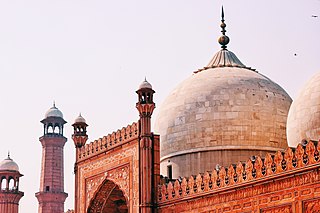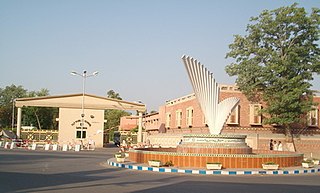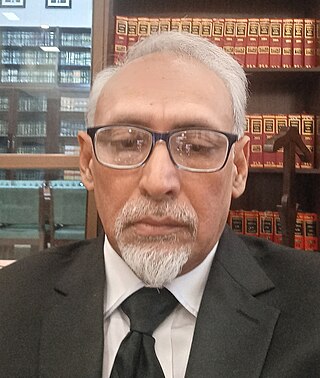
Bagh-e-Jinnah, formerly known as Lawrence Gardens, is a historical park in the city of Lahore, Pakistan. The large green space contains a botanical garden, Masjid Dar-ul-Islam, and Quaid-e-Azam Library.

The Architecture of Lahore reflects the history of Lahore and is remarkable for its variety and uniqueness. There are buildings left from the centuries of rule of the Mughal Empire, the Sikh Empire, as well as from the era of the British Raj, whose style is a mixture of Victorian and Islamic architecture often referred to as Indo-Saracenic. In addition, there are newer buildings which are very modern in their design. Unlike the emphasis on functional architecture in the west, much of Lahore's architecture has always been about making a statement as much as anything else.

The Government College University is a public research university in Lahore, Punjab, Pakistan. GCU is ranked among the most prestigious academic institutions in Pakistan. Founded as Government College, Lahore, in 1864 under British administration, it became a university in year 2002.

Sargodha is a city and capital of Sargodha Division, located in Punjab province, Pakistan. It is Pakistan's 12th largest city by population and one of the fastest-growing cities of the country. Sargodha is also known as the City of Eagles on account of hosting the headquarters of the Pakistan Air Force.
Walton Airport, also known as Walton Airfield, is situated near Model Town, 10 km (6 mi) from the city centre of Lahore, in Punjab province of Pakistan. It was founded in 1918 and is named after Sir Colonel Cusack Walton. The airport was active until 1962.

Mian Muhammad Shehbaz Sharif is a Pakistani politician and businessman who is currently serving as the 23rd prime minister of Pakistan since March 2024, having previously served in the post from April 2022 to August 2023. He has also served as the president of the Pakistan Muslim League (N) (PML-N). Previously in his political career, he served as the chief minister of Punjab three times, making him the longest-serving chief minister of Punjab.
Samanabad is an administrative zone in Lahore, Punjab, Pakistan. It forms one of 10 zones of the Lahore metropolitan area.

Anarkali Bazaar is a major bazaar in Lahore, Punjab, Pakistan. Anarkali also serves as a neighbourhood and union council of Data Gunj Buksh Tehsil of Lahore. It is situated in the region that extends from the south of Lahori Gate of the Walled City to across the Mall Road.
Sargodha Tehsil, is an administrative subdivision of the Sargodha District in the Punjab province of Pakistan. The tehsil is subdivided into 62 Union Councils - 22 of which form the city of Sargodha.

Shopping in Lahore is an important part of the social and economic culture of the city of Lahore, Pakistan. The South Asia largest and most spectacular mall Emporium Mall opened its doors on 30 June 2016.
Waheed Alam Khan is a Pakistani politician who had been a member of the National Assembly of Pakistan, from August 2018 till August 2023. Previously he was a member of the National Assembly from June 2013 to May 2018.

Orange Line is an automated rapid transit line in Lahore, Punjab, Pakistan and the first driverless metro in Pakistan. It is operated by the Punjab Mass Transit Authority and forms part of the Lahore Metro system. The line is Pakistan's first metro train. The line spans 27.1 km (16.8 mi) with 25.4 km (15.8 mi) elevated and 1.72 km (1.1 mi) underground. The line is served by 26 stations and is expected to handle 250,000 passengers daily.

The Information Technology University (ITU) is a public university in Lahore, Punjab, Pakistan. Founded in 2012, the university was founded and headed by Umar Saif and is modeled after the MIT.
Sikandar Ka Mandar is an indie folk rock band from Karachi. Since its formation in 2010, the band members have been increasingly involved in the local indie music industry in Pakistan. They released their debut, self-titled album in 2013 and have since performed on multiple occasions across the country at festivals such as the Lahore Music Meet, Storm in a Teacup, I Am Karachi, and FACE Music Mela.

Falah-e-Insaniat Foundation (FIF) was a charity organization established by Jamat-ud-Dawa and was based in Pakistan. In 2019, the Government of Pakistan banned the organization.
Bank of Bahawalpur was the central bank of the State of Bahawalpur. The bank became a subsidiary of the National Bank of Pakistan after the dissolution of the state in 1955.

NA-128 Lahore-XII is a newly-created constituency for the National Assembly of Pakistan. It mainly comprises the Model Town Tehsil along with areas of Lahore Cantonment Tehsil, Walton Cantonment and Lahore City Tehsil.
Hassan Niazi is a Pakistani film and television actor.

The 2025 South Asian Games, officially the XIV South Asian Games, will be a major multi-sport event which will be held in Pakistan, and will have Lahore, the capital of Punjab province as main host city. The cities of Faisalabad, Gujranwala, Islamabad and Sialkot will give support to Lahore hosting some sports. The Games were scheduled to be held in March 2023, but later postponed to March 2024 by SAOC members at the Olympic Council of Asia (OCA) conference in Phnom Penh, Cambodia. This will mark the third time that Pakistan has hosted the South Asian Games since 1989 and 2004, and the first time that Pakistan has hosted the event outside of Islamabad.

Akhtar Aly Kureshy is a Pakistani lawyer, advisor and senior advocate of the Supreme Court of Pakistan who served as Assistant Attorney-General for Pakistan. He remained Assistant Advocate General Punjab, and Legal Advisor to the Provincial Assembly of the Punjab.















